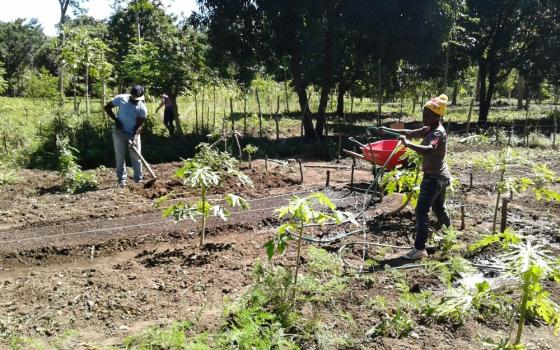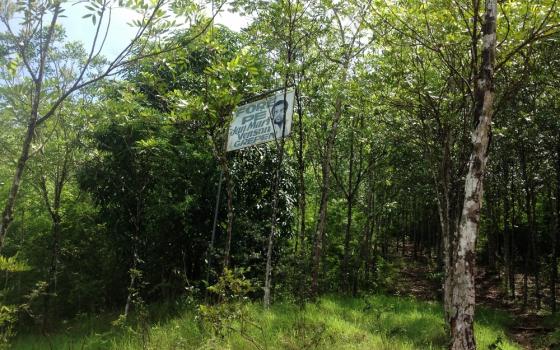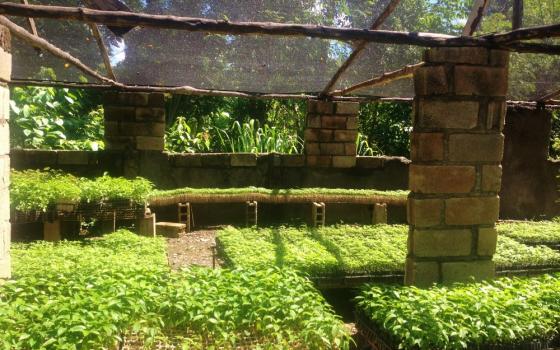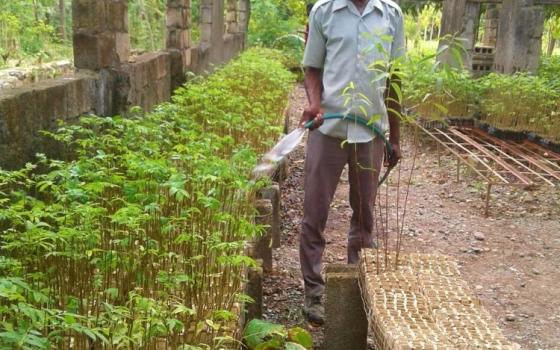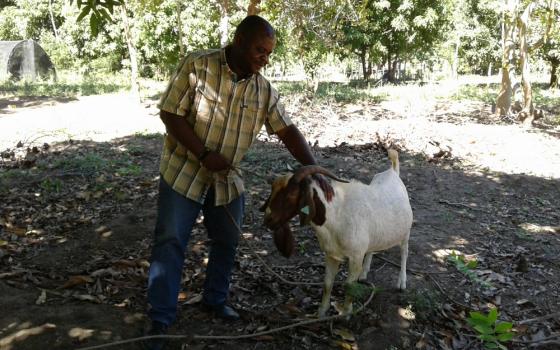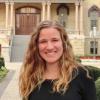Notes from the Field includes reports from young people volunteering in ministries of Catholic sisters. A partnership with Catholic Volunteer Network, the project began in the summer of 2015. This is our seventh round of bloggers: Viviana Garcia-Blanco is a Dominican Volunteer at the United Nations and Geri Lanham is a volunteer with the Religious of Jesus and Mary in Gros Morne, Haiti.
___
The Jean Marie Vincent Center, better known to locals as the Grepen Center because of its neighborhood zone, is run in collaboration between the Montfortian priests and the agronomy team of Caritas of the parish of Gros Morne.
At first glance, Grepen Center is a well-kept green place. But it is so much more than that. Tucked behind the guesthouses is a large tract of land bursting with agricultural projects and experimental gardens. The agronomy team is never idle.
These projects are made possible by and are ever-growing thanks to partnerships with the Quixote Center, the Religious of Jesus and Mary, Mercy Focus on Haiti and Parish Twinning Program of the Americas.
Located north of the large guesthouse is the tree nursery, where the three nursery technicians aim to produce 60,000 trees per year. That sounds like an impressive number, but seeing it in person is even more awe-inspiring.
My role at Grepen Center is to translate for formations, which are learning sessions that bring together small farmers and peasant organizations with people who have expertise in agricultural techniques, like double-dug gardens or drip irrigation. I work with the agronomy team at Grepen Center to determine how participants measure their mastery and success of the new techniques, and my vocabulary of and affinity for agricultural terms has grown exponentially during my two years here.
Grepen Center is responsible for a mountaintop they have reforested called Tèt Mòn, the head of the mountain. In the 1990s, the mountain was barren and dry because the trees had been cut down for fuel. But the vision of reforestation, which was first started by Sr. Pat Dillon of the Religious of Jesus and Mary and Fr. Ronel Charelus, or Father Chacha, of the Montfort Missionaries, will celebrate 20 years as a forest in 2019.
Walking up the mountain takes us through decades of history. The initial trees were planted in straight lines and seem a little silly standing at attention as living soldiers in rows. But the higher up we hike, the more natural the forest becomes.
Each time I hike up Tèt Mòn, I wish Haitians were accustomed to switchbacks instead of going straight up the mountain as the crow flies. And crows do fly in the forest! Benefits of the new trees are that the birds have returned to the area, and the land does not erode down to the river at the base of the mountain.
Each Good Friday, the Catholic community of Gros Morne hikes up Tèt Mòn together as we pray the Stations of the Cross, ending at the gazebo at the top of the mountain. It is quite the experience of faith in action to hike up a mountain with 1,000 of my neighbors as we think about the crosses each of us carries and see people literally carry their children and neighbors so everyone arrives at the top. On Good Friday, especially, I am always thankful that the trees make it possible for us to have enough oxygen to make it up this mountain.
Youth groups and schools from around the country take field trips to Tèt Mòn to see what is possible in Haiti, and each group that comes is amazed to walk among the trees and realize the potential of their land. Each year on May 1, students from the 65 schools in the Gros Morne region that make up the Green Schools Network plant trees from the Grepen tree nursery to encourage young people to appreciate trees from an early age.
But the agronomy team also realizes that charcoal is big business in Haiti. Many people use it as their cooking fuel, and it is in high demand. Since making charcoal is an income-generating activity, the agronomy team worked with the tree nursery technicians to determine which trees are best for making charcoal. They can now recommend to people a variety of oak that grows quickly and regenerates quickly, so even though they are cutting down a tree, it will be replaced.
The agronomists educate people how to responsibly cut wood, whether it be for fuel or for construction purposes. They encourage people to plant fruit trees, which people are not tempted to cut down because they give fruit year after year. Gros Morne is the mango capital of Haiti, and it is famous in particular for a variety called mango fransik. Each August, there is a festival held to celebrate the end of a successful mango season.
Each time I translate for the agronomy team, I become enthusiastic and excited about their latest project. Never before have I thought about how compost is transformed, why grafting citrus trees is such a life-giving process, what a new variety of millet might do for the local market economy, or how a simple pheromone trap could save an entire crop of sweet potatoes. These techniques are simple, but their impact causes ripples across the region.
What I most admire about the work of the agronomy team is that they are in the business of supporting and working side-by-side with peasant organization leaders and farmers. They do not do things for people or merely tell them what to do. Rather, they walk with people and get down in the dirt together so the project will be successful.
If a formation participant complains he cannot start a tree nursery because he does not have shade cloth, he is invited to see the model tree nursery that the agronomists have made with sticks and palm fronds, materials anyone can find and put together. When another participant complains she cannot plant a yard garden because she does not have a plastic planting tray, she is called over to see a yard garden planted in a broken 5-gallon bucket, something easily found in the trash collection heaps in Gros Morne.
The agronomy team does not allow program participants the easy excuse of lack of materials as a reason to not try a new agricultural endeavor that could generate economic activity for their families. Instead, they note what materials are easily available in order to show people how to value and use the resources they already have sitting around their yards. As chief agronomist Guy Marie Garçon says, the agronomy team helps people stand on their own two feet so they can begin to walk. They meet people where they are in order to take the next good step together, hand in hand.
[Geri Lanham lives in community with the Religious of Jesus and Mary in Gros Morne, Haiti.]
